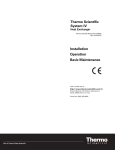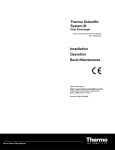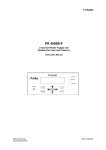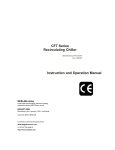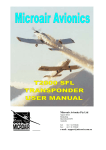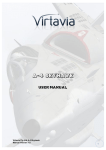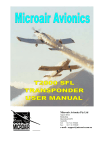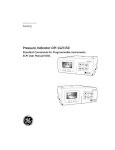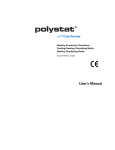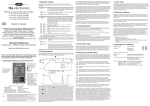Download Heating Circulators
Transcript
Heating Circulators User’s Manual Manual P/N U00973 Rev. 02/14/08 PolyStat® Heating Circulator Instruction and Operation Manual Preface Compliance ............................................................ 3 Unpacking .............................................................. 3 Warranty ................................................................. 3 Safety Warnings ................................................................ 4 General Information Description ............................................................. 5 Specifications ........................................................ 5 Installation Site ........................................................................ 6 Electrical Requirements .......................................... 6 Plumbing Requirements .......................................... 7 Fluids ..................................................................... 8 Filling Requirements .............................................. 8 Operation Controllers .............................................................. 9 Start Up .................................................................. 9 Digital Controller Main Display ......................................................... 10 Key Button Definition ............................................ 10 Viewing Setpoint ................................................... 10 Changing Setpoint ................................................ 10 Setup Loop ........................................................... 11 Calibration Loop .................................................... 12 Advanced Digital Controller Main Display ......................................................... 13 Key Button Definition ............................................ 13 Viewing Setpoint ................................................... 13 Changing Setpoint ................................................ 13 Setup Loop ........................................................... 14 Calibration Loop .................................................... 15 -1- Programmable Controller Main Display ......................................................... 16 Key Button Definition ............................................ 16 Changing Setpoint ................................................ 17 Programming Loop ................................................ 17 Setup Loop ........................................................... 18 Calibration Loop .................................................... 20 Sample Program ................................................... 21 Additional Features DB9 Connector Pinouts ........................................ 22 RS-232 Serial Communications Protocol .............. 23 High Temperature/Low Liquid Safety ..................... 24 Maintenance & Troubleshooting Cleaning ............................................................... 25 Algae .................................................................... 25 Checklist .............................................................. 25 PID Values ........................................................... 26 -2- Preface Compliance Products tested and found to be in compliance with the requirements defined in the EMC standards defined by 89/336/EEC as well as Low Voltage Directive (LVD) 73/23/EEC can be identified by the CE Mark on the rear of the unit. The testing has demonstrated compliance with the following directives: LVD, 73/23/EEC Complies with IEC/EN61010-1 EMC, 89/336/EEC IEC/EN61326-1 For any additional information, refer to the Declaration of Conformity that shipped with the unit. Unpacking Retain all cartons and packing material until the unit is operated and found to be in good condition. If the unit shows external or internal damage contact the transportation company and file a damage claim. Under ICC regulations, this is your responsibility. Warranty The Cole-Parmer circulators distributed by Cole-Parmer, Cole-Parmer warrants to the direct purchaser that the product will be free from defects in material or workmanship for a period of two years from the date of delivery. Cole-Parmer will repair or replace the product or provide credit, as its sole option, upon prompt notification and compliance with its instructions. The Distributor warrants to Customer that upon prompt notification and compliance with Distributor's instructions, that the Distributor will repair or replace, at Distributor's sole option, any Product which is defective in material or workmanship. Distributor expressly disclaims all other warranties, whether expressed, implied or statutory, including the warranties of merchantability, and fitness for a particular purpose. Distributor's sole responsibility and the Customer's exclusive remedy for any claim arising out of the purchase of any Product is repair or replacement, as described above. In no event shall Distributor's liability exceed the purchase price pain therefor; nor shall Distributor be liable for any claims, losses or damage of any third party or for lost profits or any special, indirect, incidental, consequential, or exemplary damages, howsoever arising, even if Distributor has been advised of the possibility of such damages. -3- Safety Warnings In addition to the safety warnings listed below, warnings are posted throughout the manual. These warnings are designated by an exclamation mark inside an equilateral triangle with text highlighted in bold print. Read and follow these important instructions. Failure to observe these instructions can result in permanent damage to the unit, significant property damage, personal injury or death. The lightning flash with arrow symbol, within an equilateral triangle, is intended to alert the user to the presence of non-insulated "dangerous voltage" within the unit's enclosure. The voltage may be of significant magnitude to constitute a risk of electrical shock. This label, engraved into the front of the tank lip, indicates the presence of hot surfaces. Make sure you read and understand all instructions and safety precautions listed in this manual before installing or operating your unit. If you have any questions concerning the operation of your unit or the information in this manual, contact our Sales Department. Performance of installation, operation, or maintenance procedures other than those described in this manual may result in a hazardous situation and may void the manufacturer's warranty. Transport the unit with care. Sudden jolts or drops can damage the unit's components. Observe all warning labels. Never remove warning labels. Never operate damaged or leaking equipment. Never operate the unit without fluid in the circulator. Use water unless operating above 80°C. Above 80°C use Dow 200 silicon oil. Always turn off the unit and disconnect the line cord from the power source before performing any service or maintenance procedures, or before moving the unit. Always empty the circulator before moving the unit. Never operate equipment with damaged line cords. Refer service and repairs to a qualified technician. -4- General Information Description The PolyStat® Heating Circulators are designed to provide temperature control for applications requiring a fluid work area or pumping to an external system. The units consist of a circulation pump, stainless steel reservoir, a work area cover, and a temperature controller. Specifications Temperature Range °C1 Digital Advanced Digital/Programmable H6L H13L H28L Ambient +15 to +150 Ambient +15 to +200 Ambient +15 to +150 Ambient +15 to +150 Ambient +15 to +150 Ambient +15 to +150 Temperature Stability2 Digital Advanced Digital/Programmable Pumping Capacity3 ±0.05 ±0.01 15 lpm at 0 psig (60 Hz) Heater Watts Circulator Work Area (L x W x D) Inches Centimeters Reservoir Volume Gallons Liters 800 (1000 on 50 Hz units) 5¼ x 8 x 6 13.3 x 20.3 x 15.2 5¼ x 9 x 8 13.3 x 22.9 x 20.3 121/8 x 103/8 x 8 30.8 x 26.4 x 20.3 1½ 6 37/16 13 73/8 28 IP Class Dimensions (L x W x H) Inches Centimeters Shipping Weight4 Pounds Kilograms 12 lpm at 0 psig (50 Hz) IP 21 14¾ x 9¼ x 14 37.4 x 23.0 x 35.5 15½ x 107/8 x 153/8 39.3 x 27.6 x 39.0 22¾ x 133/16 x 153/8 57.79 x 33.0 x 39.0 34 15.4 45 20.4 96 43.5 1. Ranges defined "Ambient 15 to 200" mean that the low end limit is the room ambient temperature +15C (i.e. room ambient = 20°C, low end = 20+15 = 35°C. Low end temperatures are specified using water as a test fluid. The low end limits will be valid in an ambient of 20°C at nominal line voltage. 2. Stability is measured in the center of the work area with the work area cover installed. Stability is measured at circulator fluid temperature of 60°C, ambient of 20°C, no external heat load, all voltages, frequencies, etc. with water as the fluid. 3. Pumping capacity for units operating at fluid temperature of 20°C, ambient of 21°C, with water as the fluid. 4. H28L shipping weight includes 23 pound skid. -5- Installation Site Never place the unit in a location where excessive heat, moisture, or corrosive materials are present. Locate the unit on a sturdy table or bench top. Ambient Temperature Range +50°F to +89.6°F (+10°C to +32°C) Relative Humidity Range 10% to 80% (non-condensing) Operating Altitiude Sea Level to 2000 meters (6562 feet) Overvoltage Category II Pollution Degree 2 Electrical Requirements Line voltage may be easily accessible inside the pump/control box. Always unplug the unit prior to removing the pump/control box cover. The unit construction provides protection against the risk of electric shock by grounding appropriate metal parts. The protection may not function unless the power cord is connected to a properly grounded outlet. It is the user's responsibility to assure a proper ground connection is provided. Refer to the serial number label on the rear of the unit to identify the specific electrical requirements of your unit. Ensure the voltage of the power source meets the specified voltage, ±10%. Electrical Service Required (All units): Voltage Frequency Phase Branch Circuit Requirements Line Cord Plug 115 VAC 60 Hz 1 15 A N5 - 15P 230 VAC 50 Hz 1 10 A CEE7 -6- Plumbing Requirements Ensure the unit is off before connecting tubing to the unit. To prevent damage to the plumbing lines, always support the ¾" fittings while installing/removing the pumping caps and lines. Hose Connections The pump connections are located at the rear of the pump box and are labelled (pump outlet) and (pump inlet). The connections are capped with stainless steel serrated plugs. The pump lines have ¼ inch male pipe threads for mating with standard plumbing fittings. For your convenience two stainless steel adapters, ¼ inch female pipe thread to 3/8 inch O.D. serrated fitting, are provided. (To assure proper fit, they should be installed using Teflon® tape around the threads.) Flexible tubing, if used, should be of heavy wall or reinforced construction. Make sure all tubing connections are securely clamped. Avoid running tubing near radiators, hot water pipes, etc. If substantial lengths of tubing are necessary, insulation may be required to prevent loss of cooling capacity. It is important to keep the distance between the unit and the external system as short as possible, and to use the largest diameter tubing practical. Tubing should be straight and without bends. If diameter reductions must be made, make them at the inlet and outlet of the external system, not at the unit. If substantial lengths of cooling lines are required, they should be pre-filled with bath fluid before connecting them to the unit. This will ensure that a adequate amount of fluid will be in the circulator once it is in operation. Pumping The pump is designed to deliver a flow of 15 liters/minute (4 gallons per minute) at 0 feet head. To prevent external circulation, the INLET and OUTLET lines are capped. The caps must be removed when external circulation is required. To properly secure the external hose connections to the unit, wrap Teflon® tape around the pipe line threads before installation. Once the hose connections are made, the pump must be properly plumbed to an external system. It is important the circulator is not in operation until all plumbing is complete. If the circulator is not used for external circulation, make sure the stainless steel caps are in place prior to operating the circulator. -7- Fluids Before using any fluid refer to the manufacturer's MSDS. Filtered tap water is the recommended fluid for operation from +7°C to +80°C, see Appendix A. Above +80°C, Dow 200-50 silicon oil is required. Due to potential fire hazard, do not use any other fluid above +80°C. Never use pure ethylene glycol as a fluid. A maximum 80/20 mixture of ethylene glycol and filtered tap water is allowed. Filling Requirements The circulator work area has a high and low level marker to guide filling. The markers are 1 inch horizontal slits located in the center of the stainless steel baffle separating the work area and the pump assembly. The correct fluid level falls between these two markers. The heating and cooling coils will be exposed and may become damaged if the correct fluid level is not provided. When pumping to an external system, keep extra fluid on hand to maintain the proper level in both the circulating lines and external system. Never run the unit when the work area is empty. When using Dow 200-50, ensure the work area contains no water before filling the unit. Dow 200-50 fluid will expand when heated. -8- Operation Controllers Three temperature controllers are available with the unit: Digital, Digital Advanced, and Programmable. This section explains these three controllers. Start Up Before starting the unit, check all electrical and plumbing connections and make sure the work area has been properly filled with fluid. To start any unit place the I/O switch on the side of the controller to the I (power on) position. The pump will start and the controller display will light. The controller will display the fluid temperature. If the FAULT light is illuminated see page 24. -9- Digital Controller The standard controller consists of a seven-segment LCD, unit-temperature status indicators, a three-button keypad and a user-adjustable Proportional, Integral and Derivative (PID) control. Main Display The LCD Main Display normally indicates the fluid temperature. °C °F Key Button Definition SET ENTER is used to change the current value or status of a function within the software, and then to "accept" the new value or function. NEXT is used as a means to quickly scroll through the software loops and settings. The up and down arrow keys are used to change a numeric value. Viewing Setpoint The setpoint is the desired fluid temperature. To view the setpoint, press SET ENTER. The current setpoint will flash. Press SET ENTER again to return to the temperature display. Changing Setpoint The setpoint is the desired fluid temperature. To change the setpoint, press SET ENTER. The current setpoint will flash. Use the arrow keys to change the setpoint. Scrolling includes three speed acceleration. Press SET ENTER to accept the new setpoint. NOTE: If you do not press SET ENTER, a time out will occur 30 seconds after the last key is pressed and the old setpoint will be used. - 10 - Pxx.x I x.xx Dx.xx NEXT key Setup Loop The setup loop is used to adjust the PID control and change the temperature scale. (Preset PID values are P = 1.2, I = 0.20, D = 0.00.) To enter the setup loop, from the temperature display press and hold NEXT for three seconds. The display will indicate Pxx.x. NOTE: If a key is not depressed within 60 seconds, a "time out" will occur and the display will revert to the fluid temperature. Press SET and the number will start flashing. Use the arrow keys to change the value. Press ENTER to accept the new value. Press NEXT to display the I parameter Ix.xx. Press SET and the number will start flashing. Use the arrow keys to change the value. Press ENTER to accept the new value. Press NEXT to display the D parameter Dx.xx. Press SET and the number will start flashing. Use the arrow keys to change the value. Press ENTER to accept the new value. Press NEXT to display unit. unit Press SET and the currently selected temperature scale lamp flashes. Use either arrow key to change the scale. Press ENTER to accept the new scale. Press NEXT to display the temperature. MAIN DISPLAY - 11 - Calibration Loop Lo xxx.x SET key NEXT key Use the calibration loop to recalibrate the unit's temperature display. The wider the temperature spread used, the more accurate the calibration. NOTE: Changing the factory set calibration will affect the accuracy of the controller. A time out is not used in this loop. To enter the calibration loop, from the main display press and hold the up arrow key while pressing ENTER - NEXT - ENTER. The display will indicate Lo (low calibration temperature). Press SET and the low calibration temperature will flash indicating it can be changed. NOTE: Pressing NEXT instead of SET scrolls to the high temperature calibration. Use the arrow keys to change the displayed value to the actual fluid temperature. Press ENTER to accept and the numbers will stop flashing. NOTE: The calibration will adjust to the temperature value read at the moment ENTER is pressed. Press NEXT to display hi (high calibration temperature). hi xxx.x MAIN DISPLAY Press SET and the high calibration temperature will flash indicating it can be changed. NOTE: Pressing NEXT instead of SET scrolls to Lo, the cold temperature calibration. Use the arrow keys to change the displayed value to the actual fluid temperature. Press ENTER to accept and the numbers will stop flashing. NOTE: The calibration will adjust to the temperature value read at the moment ENTER is pressed. Press NEXT to calibrate. The calibration constants are calculated and GOOD or BAD is briefly displayed to indicate whether the calibration was accepted. The display will then indicate the fluid temperature. - 12 - Advanced Digital Controller Main Display The Advanced Digital controller consists of a seven-segment LCD Display with contrast control, heating/cooling status indicators, a four-button keypad and user adjustable 0.1° or 0.01° display resolution. It also features audio/visual alarm messages, user selected high/low temperature limits, RS232 communication, and a user-adjustable Proportional, Integral and Derivative (PID) control. The LCD Main Display indicates the fluid temperature as well as the current setpoint temperature. Key Button Definition SET ENTER is used to change the current value or status of a function within the software, and then to "accept" the new value or function. YES is used to confirm a question asked within the software. NO is used to reject or change a function with in the software. NEXT is used as a means to quickly scroll through the software loops and settings. The up and down arrow keys are used to change a numeric value. Viewing Setpoint The setpoint is the desired fluid temperature. To view the setpoint, press SET ENTER. The current setpoint will flash. Press SET ENTER again to return to the temperature display. Changing Setpoint The setpoint is the desired fluid temperature. To change the setpoint, press SET ENTER. The current setpoint will flash. Use the arrow keys to change the setpoint. Scrolling includes three speed acceleration. Press SET ENTER to accept the new setpoint. NOTE: If you do not press SET ENTER, a time out will occur 30 seconds after the last key is pressed and the old setpoint will be used. - 13 - Setup Loop RESOLUTION = 0.01 Down Arrow PRESS NO TO CHANGE Up Arrow Key COOLING ENABLED NEXT key MAIN DISPLAY SETUP LOOP? The setup loop is used to change the display resolution, change the temperature scale, change temperature limits, adjust the PID values, and enable/disable RS232 communications. To enter the setup loop, press and hold NEXT for three seconds. The display will indicate SETUP LOOP? NOTE: Pressing NO displays the software version and then the Main Display. Also, the display times out 60 seconds after any key is pressed and reverts to the Main Display. PRESS NO TO CHANGE Press NEXT or YES to display COOLING ENABLED PRESS NO TO CHANGE. Ignore this display. UNITS ARE C PRESS NO TO CHANGE U=K1(C+K2)+K3 Kn=xxx.x HIGH T LIMIT xxx.xxC LOW T LIMIT xxx.xxC ENTER PID CONSTRAINTS? PROPORTIONAL TERM Press NEXT to display RESOLUTION = 0.01 PRESS NO TO CHANGE. Press NO to toggle the resolution between 0.1° and 0.01°. Press NEXT to display UNITS ARE C PRESS NO TO CHANGE. Press NO to toggle the scale between Fahrenheit (F), Celsius (C) or a user (U) scale. NOTE: The following is needed only if a user (U) scale was selected. Press NEXT to display U = K1(C + K2) + K3 Kn=xxx.x. Press SET and then use the arrow keys to change the K values. Press NEXT to display HIGH T LIMIT xxx.xxC LOW T LIMIT xxx.xxC. Press SET to be able to use the arrow keys to change the high temperature limit. Press ENTER to accept the new value. Press SET again to be able to change the low temperature limit. Press ENTER to accept the new value. NOTE: To bypass changing the high temperature value press SET twice when HIGH T LIMIT xxx.xxC LOW T LIMIT xxx.xxC is initially display. P=xx.x% OF SPAN INTEGRAL TERM I=x.xx REPEATS/MIN DERIVATIVE TERM D=x.xx MINUTES MAXCOOLINGDISABLED PRESS NO TO CHANGE RS232 DISABLED PRESS NO TO CHANGE Press NEXT to display ENTER PID CONSTANTS? Press NO to bypass changing the constants and display SAVE SETUP? Press YES or NEXT to display PROPORTIONAL TERM P = xx.x% OF SPAN. Press SET and then use the arrow keys to change the value. Press NEXT to display INTEGRAL TERM I = x.xx REPEATS/MIN. Press SET and then use the arrow keys to change the value. Press NEXT to display DERIVATIVE TERM D = x.xx MINUTES. Press SET and then use the arrow keys to change the value. Press NEXT to display MAX COOLING DISABLED PRESS NO TO CHANGE. Ignore this display. Press NEXT to display RS232 IS DISABLED PRESS NO TO CHANGE. Press NO to toggle between disabled and enabled, or press ENTER to use the displayed mode. Press NEXT to display SAVE SETUP? PRESS YES OR NO. Press YES to accept all the changes. Press NO to ignore all of them. With either choice the unit will return to the Main Display. SAVE SETUP? PRESS YES OR NO MAIN DISPLAY - 14 - Calibration Loop NOTE: The Calibration Loop is not accessible if RS232 communications is enabled. Use the calibration loop to calibrate the RTD temperature probe. The wider the temperature spread used, the more accurate the calibration. NOTE: Changing the factory set calibration will affect the accuracy of the controller. A time out is not used in this loop. CALIBRATE RTD? Down Arrow Up Arrow Key CALIBRATE LOW TEMP? NEXT key MAIN DISPLAY Press NEXT and the display indicates CALIBRATE LOW TEMP? To perform a low temperature calibration press YES or NEXT and the display will indicate CAL RTD LOW TEMP xxx.xxC. Press SET and then use the arrow keys to change the displayed value to the actual fluid temperature (as measured with a calibrated reference thermometer). Press NEXT until the display indicates SAVE CALIBRATION PRESS YES OR NO. Press YES to save the change. The display will momentarily indicate BOTH HIGH AND LOW CAL MUST BE DONE then return to the main display. CAL RTD LOW TEMP Run the temperature to a suitable low-end value. Once stabilized enter the calibration loop. From the main display press and hold NEXT while pressing, within three seconds, ENTER - NO - ENTER. The display will indicate CALIBRATE RTD? xxx.xxC CALIBRATE HIGH TEMP? CAL RTD HIGH TEMP xxx.xxC SAVE CALIBRATION? PRESS YES OR NO MAIN DISPLAY Run the temperature to a suitable high-end value. Once stabilized reenter the calibration loop. Press YES or NEXT until the display indicates CALIBRATE HIGH TEMP? To perform a high temperature calibration press NEXT and the display will indicate CAL RTD HIGH TEMP xxx.xxC. Press SET and then use the arrow keys to change the displayed value to the actual fluid temperature (as measured with a calibrated reference thermometer). Press NEXT and the display will indicate SAVE CALIBRATION PRESS YES OR NO. Press YES to save the change. The unit will return to the main display. - 15 - Programmable Controller The programmable controller consists of a seven-segment LCD with contrast control, heating/cooling status indicators, a 12-button keypad and user adjustable 0.1° or 0.01° temperature display resolution, external sensor input with automatic switching in the event of external sensor failure. It also features audio/visual alarm messages, automatic fixed temperature limit, user selected high/low temperature limits, programmable temperature profile, RS-232 communication and a user-adjustable Proportional, Integral and Derivative (PID) control. Main Display The LCD normally indicates the fluid temperature as well as the current setpoint temperature, or the external temperature and setpoint. Key Button Definition SET ENTER is used to change the current value or status of a function within the software, and then to "accept" the new value or function. YES is used to confirm a question asked within the software. NO is used to reject or change a function within the software. NEXT is used as a means to quickly scroll through the software loops and settings. ± is used to change the current numeric value from positive to negative, or negative to positive. SETUP is used to enter the controller's setup loop. PROG is used to enter the controller's program loop. ESC is used to backtrack to the previous screen within a software loop. The up and down arrow keys are used to change a numeric value. 1 - 9 keys are used to enter a number. - 16 - Changing Setpoint To view or change the setpoint, press SET ENTER. The current setpoint will flash. If the number to be entered is negative, press the +/- key. Otherwise, enter the most significant digit of the number. The digit will appear in the least significant decimal position. As each digit is entered the previously entered digits will shift up in significance. Enter trailing zeros as needed to obtain the desired order of magnitude. Press SET ENTER to accept the new setpoint. NOTE: If you do not press SET ENTER, a time out will occur 30 seconds after the last key is pressed and the old setpoint will be used. RUN PROGRAM B? EDIT PROGRAM A? A SET STEP n TIME hhh:mmm A xxx.xxC REPETITIONS FINAL SETPT nnn xxx.xxC B SET STEP n TIME hhh:mmm xxx.xxC REPETITIONS FINAL SETPT SAVE PROGRAMS? ESC key To enter the program loop, press and hold PROG for three seconds. The display will indicate RUN PROGRAM A? NOTE: A time out will occur 60 seconds after the last key is pressed and the program will revert to old values and the display will revert to the fluid temperature. The unit's are not shipped with stored programs. Before a program can be run, it has to be edited and stored. Therefore, for initial programming or program editing press NEXT to display RUN PROGRAM B? and then press NEXT again to display EDIT PROGRAM A? Press YES or NEXT to display the temperature, step number and time duration. Steps start at 0. Press SET ENTER and using the keypad enter the setpoint temperature. Press SET ENTER. Press SET ENTER and enter the number of hours. Press SET ENTER. Press SET ENTER and enter the number of minutes. Press SET ENTER. The display will increment to step 1. Repeat the procedure for the total number of desired steps. To skip a number press SET ENTER twice. To end a program with fewer than ten steps, enter 0 hours and 0 minutes. EDIT PROGRAM B? B NOTE: The program loop is not accessible if the RS-232 communications is enabled, see Setup Loop. The program loop is used to program the controller. The controller can store up to two programs, each with as many as ten steps. (Refer to the Setup Loop on the next page for other options.) A sample program is shown on page 21. MAIN DISPLAY Down Arrow NEXT key RUN PROGRAM A? Up Arrow Key Program Loop nnn xxx.xxC Press NEXT to display the number of program repetitions. Press SET ENTER and enter the number of reps. Press SET ENTER. Press SET ENTER and enter the final setpoint for the program. Press SET ENTER. Press NEXT to display EDIT PROGRAM B? Use the same procedures. Press NEXT to display SAVE PROGRAMS? Press YES to save or NO to ignore. The unit returns to the main display. MAIN DISPLAY With program(s) saved, when the display reads RUN PROGRAM pressing YES will start the program, pressing NO will stop it. With either choice the unit returns to the main display. - 17 - Setup Loop NOTE: The setup loop is not accessible if a program is running. If RS-232 communications is enabled, only the RS-232 portion of the setup loop is active. RESOLUTION = 0.01 PRESS NO TO CHANGE UNITS ARE C ESC key WHEN SETPOINT >xxC Down Arrow REFRIGERATION OFF Up Arrow Key SETUP LOOP? NEXT key The setup loop is used to change the display resolution, change the temperature scale, change temperature limits, adjust the PID control (preset PID values are P = 1.2, I = 0.20, D = 0.05.), selects internal or external probe, enter the MAIN DISPLAY maximum internal and external temperature difference and enable RS-232. To enter the setup loop from the main display, press and hold SETUP for three seconds. The display will indicate SETUP LOOP? NOTE: A time out will occur 60 seconds after the last key is pressed and the display will revert to the fluid temperature. PRESS NO TO CHANGE Press YES or NEXT to display REFRIGERATION OFF WHEN U=K1(C+K2)+K3 SETPOINT>xxC. Ignore this display. Kn=xxx.x HIGH T LIMIT xxx.xxC LOW T LIMIT xxx.xxC Press NEXT to display RESOLUTION = 0.01 PRESS NO TO CHANGE. Press NO to toggle between 0.1°C and 0.01°C display resolution, press YES or NEXT to maintain the displayed resolution. ENTER PID CONSTRAINTS? PROPORTIONAL TERM P=xx.x% OF SPAN INTEGRAL TERM I=x.xx REPEATS/MIN Press NEXT to display UNITS ARE C PRESS NO TO CHANGE. Press NO to toggle between temperature scales Celsius (C), Fahrenheit (F) and a user defined (U) scale. Press YES or NEXT to maintain the displayed scale. NOTE: The following is used only if a user (U) scale was selected. Press NEXT to display U = K1(C + K2) + K3 Kn=xxx.x. Press SET ENTER and use the keypad to change the values. DERIVATIVE TERM D=x.xx MINUTES PROBE IS INTERNAL PRESS NO TO CHANGE MAX INTERN EXTERN TEMP DIFFERENCE xxC Press NEXT to display HIGH T LIMIT xxx.xxC LOW T LIMIT xxx.xxC. Press SET ENTER and enter the high temperature limit. Press SET ENTER to accept the new value. Press SET ENTER again to be able to change the low temperature limit. Press SET ENTER to accept the new value. NOTE: To bypass changing the high temperature value press SET ENTER twice when HIGH T LIMIT xxx.xxC LOW T LIMIT xxx.xxC is initially display. RS232 DISABLED PRESS NO TO CHANGE MAX COOLING DISABLED PRESS NO TO CHANGE SAVE SETUP? PRESS YES OR NO Press NEXT to display ENTER PID CONSTANTS? Press NO to bypass changing the constants and display PROBE IS INTERNAL PRESS NO TO CHANGE or press NEXT to display PROPORTIONAL TERM P = xx.x% OF SPAN. Press SET ENTER and use the keypad to enter the desired value. MAIN DISPLAY - 18 - Press NEXT to display INTEGRAL TERM I = x.xx REPEATS/MIN. Press SET ENTER and use the keypad to enter the desired value. Press NEXT to display DERIVATIVE TERM D = x.xx MINUTES. Press SET ENTER and use the keypad to enter the desired value. Press NEXT to display PROBE IS INTERNAL PRESS NO TO CHANGE. Press NO to toggle between internal or external probe or press YES or SET ENTER to use the displayed probe. Press NEXT to display MAX INTERN EXTERN TEMP DIFFERENCE xxC. Press SET ENTER and use the keypad to enter the desired value. Press NEXT to display RS232 IS DISABLED PRESS NO TO CHANGE. Press NO to toggle between disabled and enabled or press YES or SET ENTER to use the displayed mode. Press NEXT to display MAX COOLING DISABLED PRESS NO TO CHANGE. Ignore this display. Press NEXT to display SAVE SETUP? PRESS YES OR NO. Press YES to accept the changes. Press NO to ignore them. The unit will return to the main display. - 19 - Calibration Loop NOTE: The calibration loop is not accessible if a program is running or if RS-232 communications is enabled. Use the calibration loop to calibrate the internal and external RTD temperatures. NOTE: Changing the factory set calibration will affect the accuracy of the controller. A time out is not used in this loop. CALIBRATE? CALIBRATE LOW TEMP? INTERNAL LOW TEMP xxx.xxC CALIBRATEHIGHTEMP? ESC key Down Arrow CAL INTERNAL RTD? Up Arrow Key NEXT key MASTER DISPLAY Run the temperature to a suitable low-end value. Once stabilized enter the calibration loop. From the main display press and hold NEXT while pressing ESC - ENTER - ESC. The display will indicate CALIBRATE? Press YES or NEXT and the display indicates CAL INTERNAL RTD? Press YES or NEXT and the display indicates CALIBRATE LOW TEMP? Press NEXT and the display indicates INTERNAL LOW TEMP xxx.xxC. Press SET and use the keypad to change the displayed value to the actual fluid temperature (as measured with a calibrated reference thermometer). Press NEXT until the display indicates CAL EXTERNAL RTD? Use the same procedure to calibrate the external probe (if desired). Press NEXT until the display indicates SAVE CALIBRATION PRESS YES OR NO. Press YES to save the changes. The display will momentarily indicate BOTH HIGH AND LOW CAL MUST BE DONE then return to the main display. INTERNAL HIGH TEMP xxx.xxC CAL EXTERNAL RTD? Run the temperature to a suitable high-end value. Once stabilized reenter the calibration loop. Repeat the same procedure for the high temperature calibration. Press NEXT and the display will indicate SAVE CALIBRATION? PRESS YES OR NO. Press YES to save the changes. The unit will return to the main display. CALIBRATE LOW TEMP? EXTERNAL LOW TEMP xxx.xxC CALIBRATEHIGHTEMP? EXTERNAL HIGH TEMP xxx.xxC SAVE CALIBRATION? PRESS YES OR NO MASTER DISPLAY - 20 - Sample Program This sample program A has three steps and two repetitions. The final setpoint is 35.0°C. Enter these values as described on page 17. Stepn 0 1 2 3 SETxxx.xxC 25.0 20.0 30.0 NA* REPETITIONS TIME nnnn 2 hhh 0 0 0 0 mmm 2 3 1 0 FINAL SETPT xxx.xC 35.0 * Any value can be entered. Pressing YES to RUN PROG A? returns to the MAIN DISPLAY which now has a lower line reading: PGM A 0 w 25.0C A is the current program, 0 is the current step, w indicates a waiting phase (described in the next paragraph) and 25.0 is the current setpoint. A w is displayed when the program is waiting for the bath to heat or cool from the previous setpoint to the current setpoint. When the bath temperature gets to within 0.5° of the current setpoint, the display changes to PGM A 0 r 25.0, the r indicating the running phase for that step. Actual step time starts when the display turns to r. The following graph displays this program and indicates the lower half of the MAIN DISPLAY. 35°C 30°C 25°C REPETITION 1 SETPOINT 35.0C PGM A 2 r 30.0C PGM A 2 w 30.0C STEP 2 PGM A 1 r 20.0C PGM A 1 w 20.0C STEP 1 PGM A 0 w 25.0C PGM A 0 r 25.0C STEP 0 PGM A 2 r 30.0C PGM A 2 w 30.0C STEP 2 PGM A 1 r 20.0C PGM A 1 w 20.0C STEP 1 PGM A 0 r 25.0C STEP 0 PGM A 0 w 25.0C 20°C REPETITION 2 NOTE: There is no indication on the display as to which repetition the program is in. - 21 - Additional Features DB9 Connector Pinouts RS232 Connections DB9 Female (J3) 5 Common 3 Receive (RxD) (Data from computer) 2 Transmit (TxD) (Data to Computer) External RTD DB9 Male (P2) 3 RTD2A 4 RTD2A 8 RTD2B - 22 - RS232 Serial Communications Protocol Baud rate: Parity: Data bits: 9600 none 8 Stop bits: Flow control: 1 none Commands Description (UPPERCASE only) Response ?[CR] Help Protocol Examples A1[CR] Reports “OK” to indicate that RS232 is enabled S?[CR] Report temperature setpoint Sn[CR] Change temperature setpoint to n F?[CR] Report bath temperature n[CR]OK[CR][CR] U?[CR] Report bath temperature units (x = C, F or U) x[CR]OK[CR][CR] C[CR] Change temperature units to °C [CR]OK[CR][CR] F[CR] Change temperature units to °F [CR]OK[CR][CR] U[CR] Change temperature units to °U (user defined units) [CR]OK[CR][CR] &LH?[CR] Report high temperature limit n[CR]OK[CR][CR] &LL?[CR] Report low temperature limit n[CR]OK[CR][CR] &LHn[CR] Change high temperature limit to n [CR]OK[CR][CR] &LLn[CR] Change low temperature limit to n [CR]OK[CR][CR] &P?[CR] Report temperature resolution (number of decimal places) &Pn[CR] Change temperature resolution (n = 1 or 2) [CR]OK[CR][CR] n[CR]OK[CR][CR] [CR]OK[CR][CR] n[CR]OK[CR][CR] [CR]OK[CR][CR] [CR] = carriage return n = numeric data Error Messages INPUT OR RANGE ERROR[CR][CR] REQUEST DENIED[CR][CR] - 23 - Description Controller received a setpoint that was out of range. Setpoint can be changed only while: Displaying temperature A value is not currently being entered Not in program mode. High Temperature/ Low Liquid Level Safety To protect your application, the adjustable High Temperature/Low Liquid Level Safety (HIGH TEMP/LOW LEVEL) ensures the heater will not exceed temperatures which can cause serious damage to your unit. A single temperature sensor, located on the heater coils in the circulator, monitors both conditions. A High Temperature/Low Liquid Level fault occurs when the temperature of the sensor exceeds the set temperature limit. In the event of a fault, the unit will shut down and a FAULT LED will illuminate. The cause of the fault must be identified and corrected before the unit can be restarted. To set the safety, locate the HIGH TEMP/LOW LEVEL SAFETY adjustment dial in back of the pump box. Turn the dial fully clockwise. Start the unit. Adjust the setpoint for a few degrees higher than the highest desired fluid temperature and allow the circulator to stabilize at the temperature setpoint. Turn the HIGH TEMP/LOW LEVEL SAFETY dial counterclockwise until you hear a click and the unit shuts down. The red FAULT LED on the temperature controller will light to indicate a fault has occurred. Cool the circulator and then, without moving the adjustment dial, turn the unit off then back on. - - 24 - HTC + Maintenance & Troubleshooting Cleaning Turn the unit off before cleaning. Allow sufficient for the fluid to cool to room temperature before handling. Routine cleaning can be achieved by simply sponging down the seamless stainless steel tank with a mild soapy solution. Do not use steel wool; its abrasiveness will lead to rusting. Dry the circulator using a soft cloth. Algae To restrict the growth of algae in the circulator, we recommend the circulator cover be kept in place and that all circulation lines be opaque. This will eliminate the entrance of light required for the growth of most common algae. We recommend the use of Chloramine-T, 1 gram per 3.5 liters. Checklist Unit will not start Make sure the voltage of the power source meets the specified voltage, ±10%. Refer to the serial number label on the rear of the unit to identify the specific electrical requirements of your unit. Check the High Temperature/Low Liquid Level Safety. If the FAULT light is on, make sure the fluid level in the circulator is between the marks in the baffle and the HIGH TEMP/LOW LEVEL SAFETY setting is greater than the fluid temperature. Turn the unit's I/O switch off then back on to reset the safety. No external circulation Make sure the stainless steel plugs on the PUMP INLET and PUMP OUTLET have been removed. Check for obstructions, kinks, or leaks in the circulation tubing. Circulation will cease when the pump head has been exceeded. PID Values The PID values can be verified in the controller's Setup Loop. The factory preset PID values are: Digital P = 1.2 I = 0.20 D = 0.00 Digital Advance P = 1.2 I = 0.20 D = 0.05 Programmable P = 1.2 I = 0.20 D = 0.05 - 25 - Appendix Fluids Water Quality Standard and Recommendations Microbiologicals (algae, bacteria, fungi) Inorganic Chemicals Calcium Chloride Magnesium Sulfate Total Hardness Permissible (PPM) Desirable (PPM) 0 0 <25 <25 <12 <25 <17 <0.6 <10 <0.1 <1 <0.05 Unfavorably high total ionized solids (TIS) can accelerate the rate of galvanic corrosion. These contaminants can function as electrolytes which increase the potential for galvanic cell corrosion and lead to localized corrosion such as pitting which can be observed at the studs and on the outside surface of cooling coils. Eventually, the pitting will become so extensive that the coil will leak refrigerant into the water reservoir. For example, tap water in the U.S. averages 171 ppm (of NaCl). The recommended level for use in a water system is between 0.5 to 5.0 ppm (of NaCl). Recommendation: Initially fill the tank with distilled/deionized water. Do not use untreated tap water as the total ionized solids level may be too high. Maintain this water quality at a resistivity of between 1 to 10 MOhmcm (compensated to 25°C) by using a purification system. Although the initial fill may be as high as 18 MOhmcm (compensated to 25°C), the desired level for long time usage is 1 to 3 MOhmcm (compensated to 25°C). The above two recommendations will reduce the electrolytic potential of the water and prevent or reduce the galvanic corrosion observed.




























